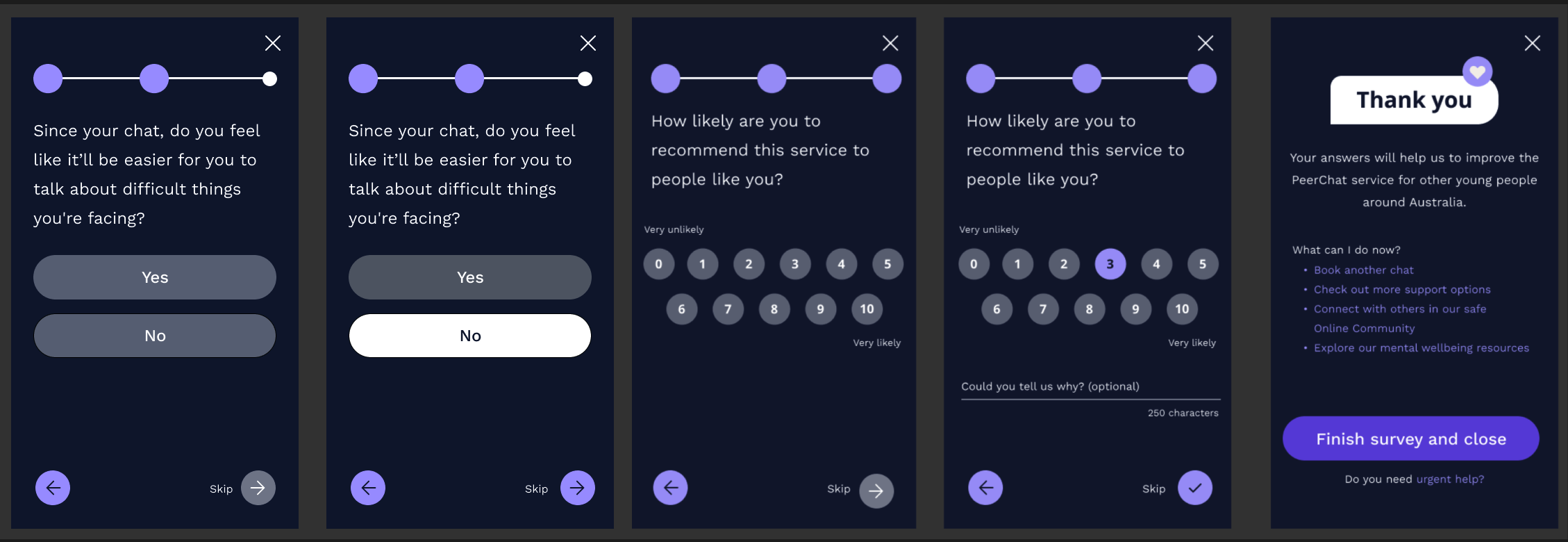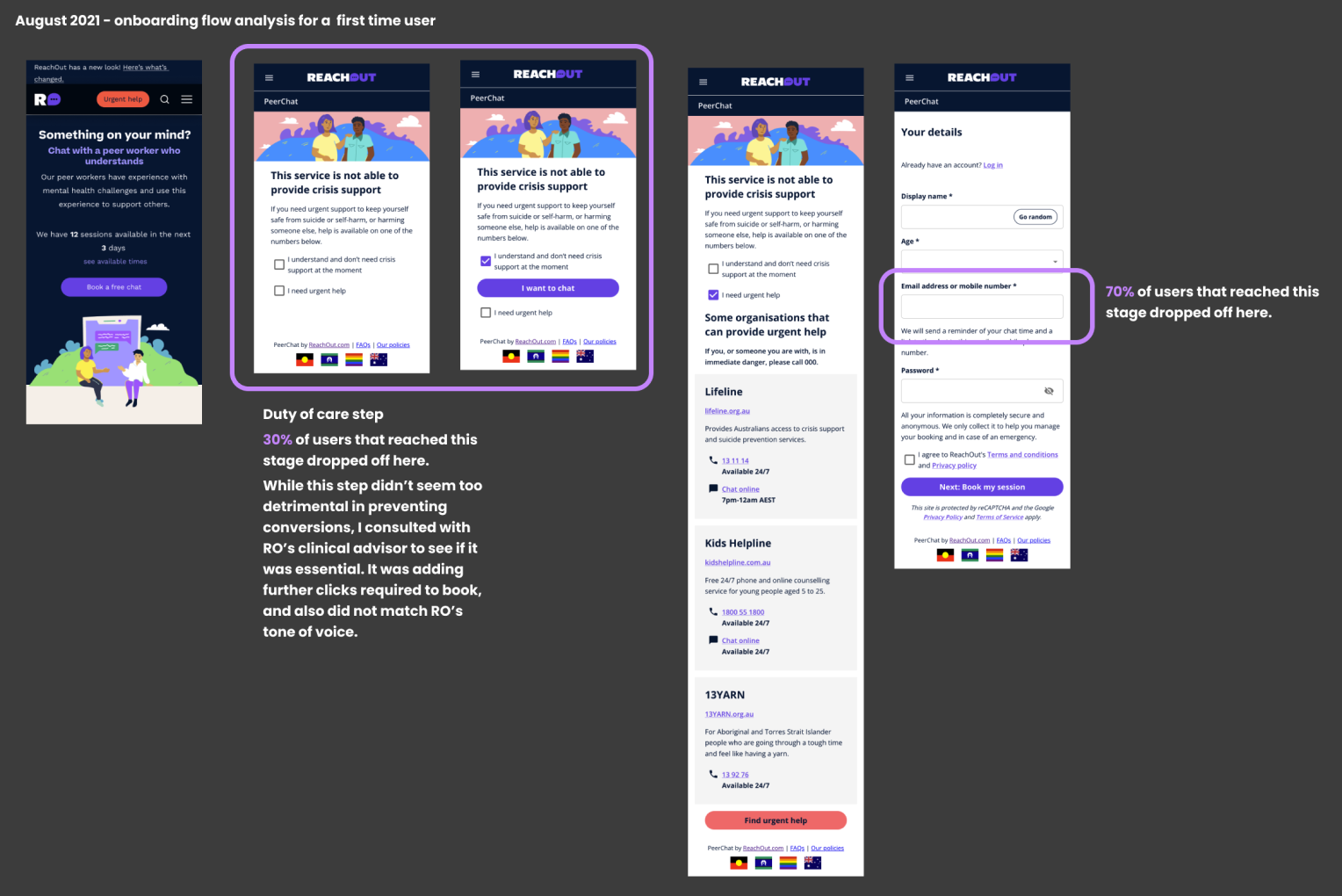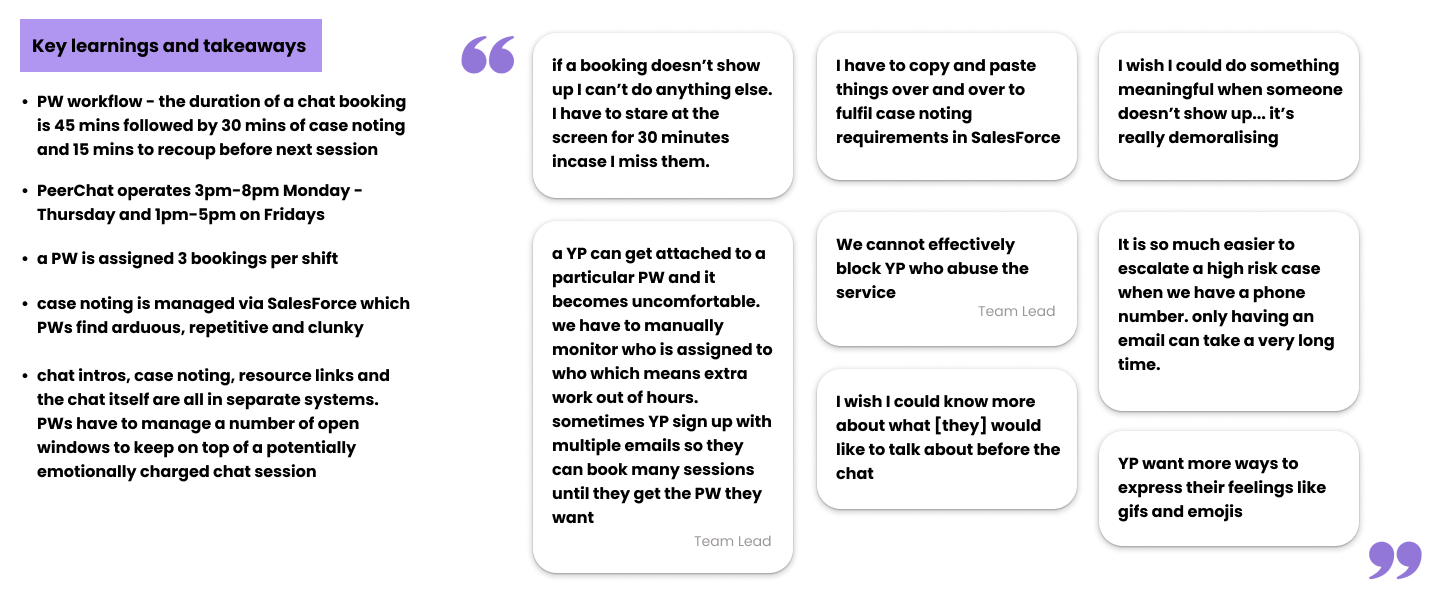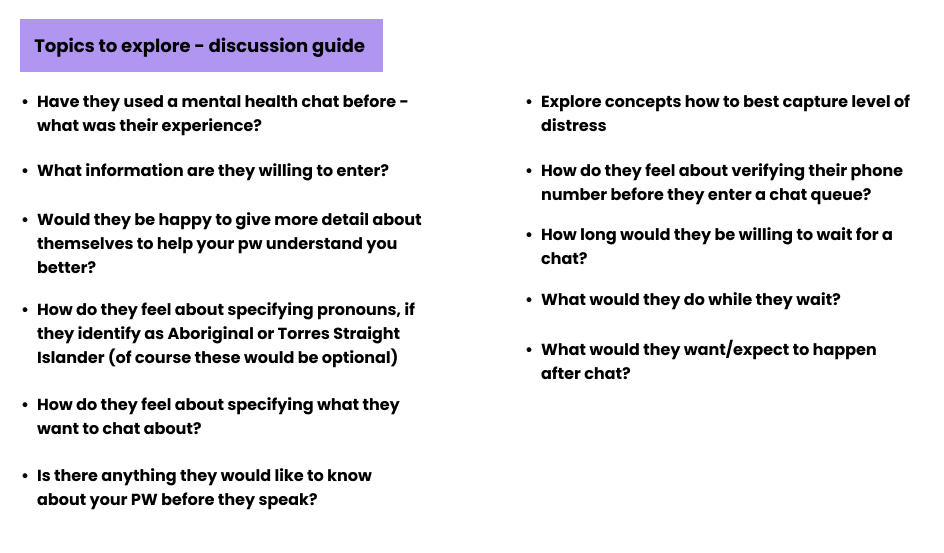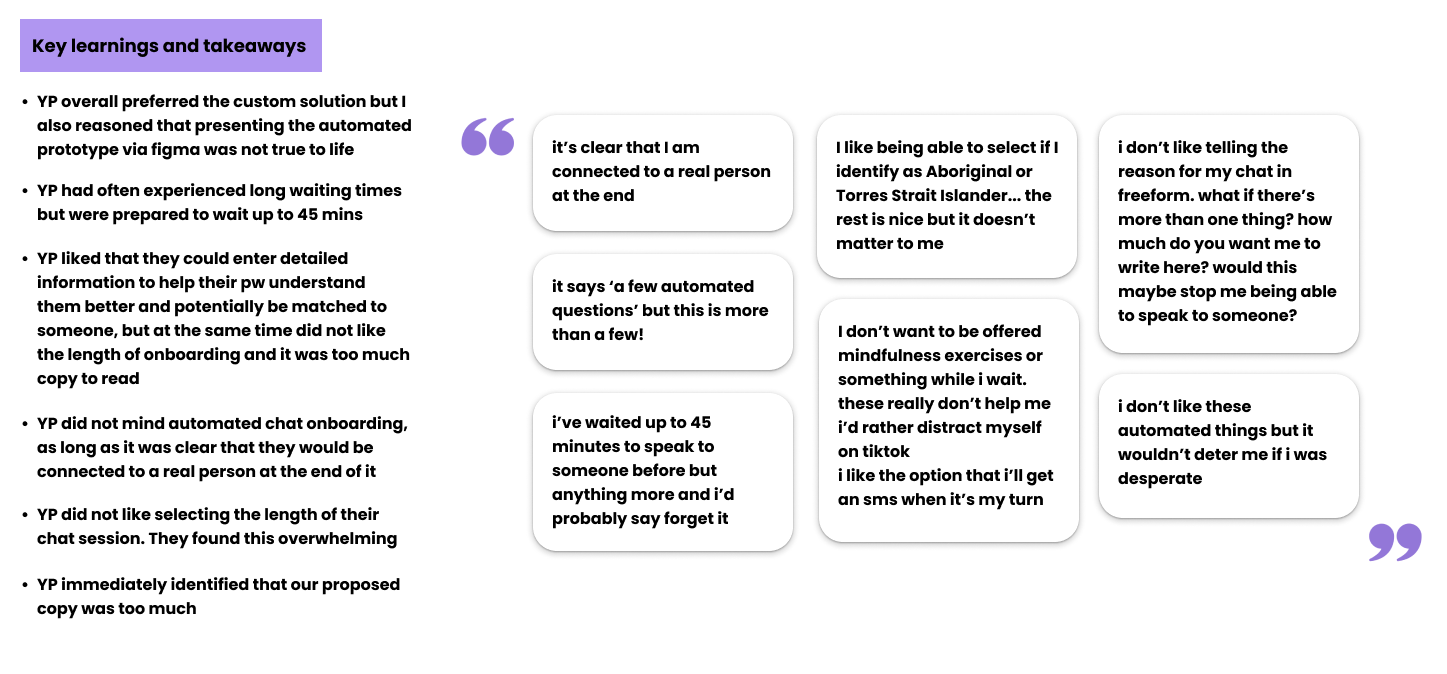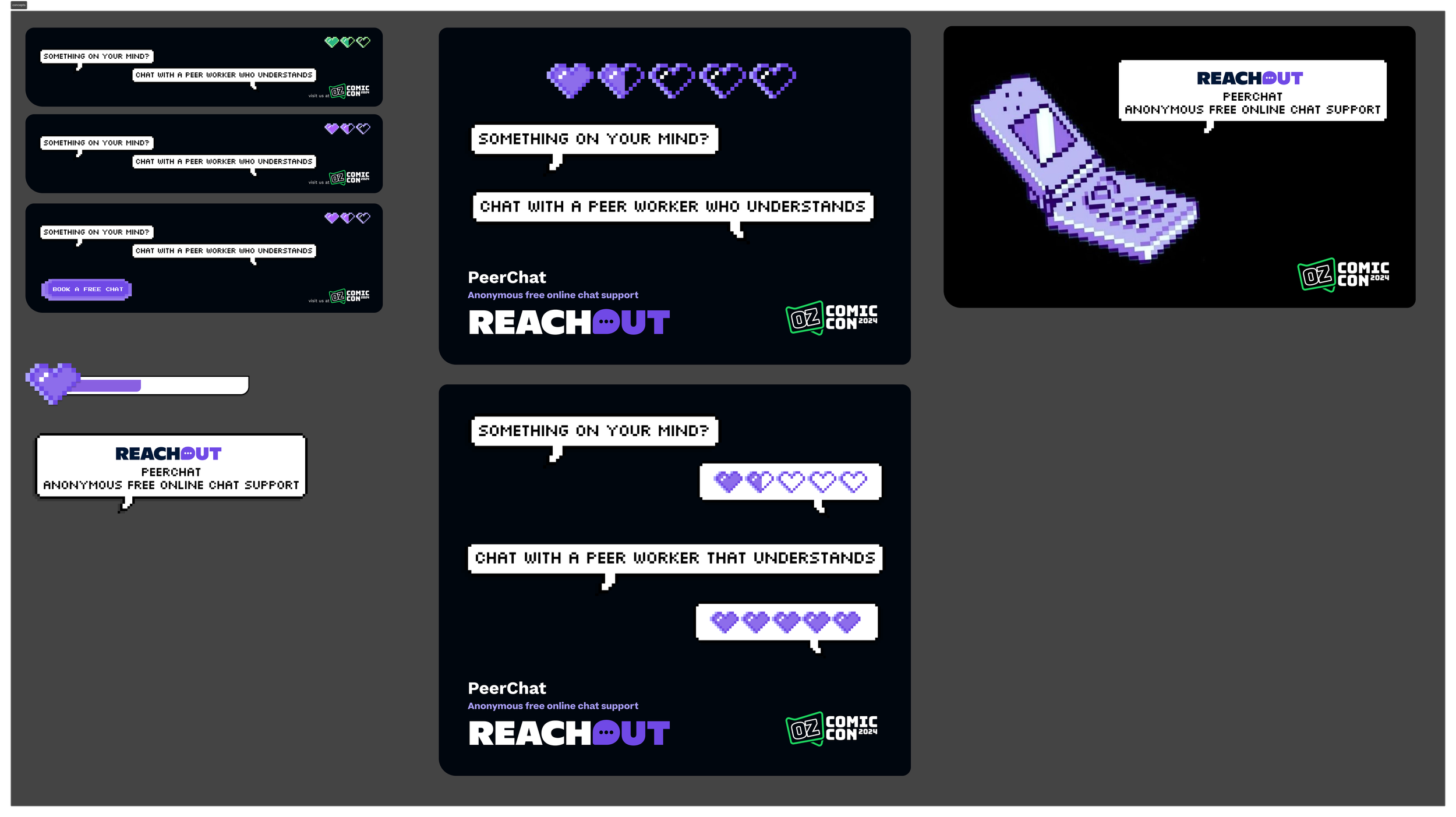Date
Dec 2022 - Sept 2024
My Role
Product Designer
About the Product:
ReachOut Australia is a not-for-profit online service offering mental health support for Australians aged 13-25. One of their core products is PeerChat - a free, confidential, online chat service which connects young people with peer workers who are specially trained to help others based on their own lived experiences.
PeerChat first launched mid-2022 and my last 2 years have been spent developing and optimising the product through design and research.
This deep dive covers the three main stages of this project:
1. Designing a way to measure the social impact of the service
2. Revising the onboarding flow to address drop off rates, and finding ways to encourage retention
3. Improving number of users NOT attending bookings and lowering the internal cost per session
For context, the original product worked by opting to book a session via RO’s website, entering personal details, selecting a time and then attending the session via a link sent by email or sms. The sessions are conducted via a web based chat application built in-house.
As a not-for-profit, reliant on external funding and obligated to report to the department of health and other bodies, PeerChat needed a way for young people to evaluate their feelings after their session and to rate and give feedback.
Initially at the end of the chat, the user was asked to use a clunky sliding scale giving a range of happy/sad emojis as a rudimentary way for RO to gather satisfaction data for reporting. It was quickly identified that this was not of much value and many users dismissed it without interaction.
I worked closely with the product manager and the social impact team to break down what input mattered most. This lead to the vision of much more granular data being gathered at the end of each session.
Key challenges:
* how to present something quite complex into something intuitive and engaging that would encourage a young person who may have potentially had an emotional session to leave feedback
* how to maintain trust that any feedback left would remain confidential
* how to condense the survey into a maximum of 3 screens (I deemed any more to be excessive)
* how to offer pathways for further support after a session
During the initial stakeholder kickoff there was an appetite for animated emojis and a lot of deliberation of what wording was needed for reporting in a way that young people would understand and not be overwhelmed.
I immediately felt against animation and emojis, feeling they could overwhelm and being aware there is a high number of users with neurodiversity - however I did want to create something that would delight and was interactive. After several iterations I settled on a simple slider component aligning various weather states to mood:
Final concepts to capture user’s sense of wellbeing post-chat. The static weather states subtly transition as the user selects their mood.
I kept the remainder of the survey simple. Despite many reviews and user testing, I was unable to condense the copy further without jeopardising what was essential for reporting.
User testing
Testing these concepts was one of the most enjoyable rounds of user testing I have experienced in my career. Interviewing brutally honest young people who have had past experience with mental health challenges or lived experience is never easy but the feedback and smiles from the weather concept was overwhelming. This was enough for sign off and to get working with a developer to build.
We interviewed 8 young people showing them A/B concepts with the main sticking point being the of the second question, and the pathways offered once the survey was submitted.
Given the positive response of the new check in, I advocated that we add to to the start of session too so that we could compare user’s moods before and after. This also gave me the chance to consolidate the design and make the flow from start to finish more consistent.
User flow before a chat session
Outcome
A new and successful way to capture impact was implemented and PeerChat was injected with a refreshed UI and UX aligned with RO’s new branding (released 2022).
It is worth noting however that this project also identified that the tech debt that was mounting with the platform being built in-house.
While PeerChat was growing successfully, there were two main pain points in conversion:
1. ~70% of young people engaging in the booking flow would drop off as soon as asked to provide an email or phone number
2. ~60% of young people who did book a session did not attend (addressed in stage 3)
I looked at the data of the onboarding flow and found the two most prominent statistics in drop-off rates:
It’s worth noting here, it made no sense to me that a user could not see the available bookings BEFORE they entered their details. I disagreed with the marketing consultants that this was a good thing, however re-ordering the form would require detailed IA restructure and the dev team had limited capacity.
So what could be done to improve conversion with not too much investment from the dev team?
My solution:
1. Remove the duty of care step. From interviewing SME’s I found that it was not preventing high risk users booking and attending sessions so instead I opted to add a bold red Urgent help CTA (a route to other contacts such as Lifeline, Beyond Blue etc) into the navigation header.
2. Add additional copy to reassure the user that their data is completely confidential and only required in case of an emergency. This included re-ordering the sign up form to put this information above the fold.
3. Update fields to MUI components for easier interactions, a less cluttered screen and to improve accessibility to users.
4. Finally, create and send ONE automated email or sms to new users who had signed up but not booked a session to let them know the service is there for them any time they need it.
Revised flow lo-fi with my solutions.
As part of this process, and aware of mounting marketing costs that were not translating to conversion, I also took stock of the existing landing page.
I sent out a simple survey to RO’s “content squad” - a team of young people who would review and give feedback on content and asked them to describe the service and how they interpreted it.
It was clear that young people lacked confidence in the service because they did not understand what a peer worker was, what the service could and could not offer and what to expect from their session.
I also consulted with RO’s SEO agency about key search terms and advocated that we add an in-depth stand alone FAQ page.
Simplified landing page concept
As PeerChat reached it’s 2 year anniversary, it was identified that the cost per session provided was not sustainable for the service to scale. Whilst I cannot share the exact cost statistics and end goal here, the aim to drop the cost was ambitious. There was an internal appetite from RO’s leadership team that rather than having a booked session model, users should be able to access a chat on-demand during opening hours.
Discovery phase
After conducting a full landscape review of such models across the UK, USA and Australia I teamed with a Product Manager and a Service Designer to tackle the problem.
The starting point was to interview internal stakeholders and SMEs (the peer work team) to identify pain points in efficiency, processes and user behaviour. The main issue, as mentioned before, is that ~60% of young people who sign up do not attend their session, leaving the allocated peer worker paid but not working for 90 minutes.
Some rationale to no shows included;
* a user would book a session when distressed but then feel a sense of relief and not attend
* a user would book many sessions under different email aliases to try and be allocated to their chosen peer worker (they were allocated randomly)
* a user may not check their email in a timely manner and miss booking information
* a user simply forgets about bookings
As a first step in Discovery we interviewed the PeerChat team as SME’s to learn more about their day-to-day and learn more about their pain points:
note: PW= peer worker, YP= young person
We also asked how peer workers would feel about an on-demand service vs a booked model. Most were excited but some were concerned about increased workload in an already emotional environment. It became a key factor moving forward that any solutions must focus on efficiency and must maintain a manageable level of work for the team.
The next step was to gauge how young people feel about instant chats in the mental health field.
I then built some lo-fi prototypes and recruited 8 young people via Askable to have video call interviews. I used a quality of life survey to select a cohort that had lived experience and had used similar services before.
At this stage of the project we had been exploring out-of-the box solutions to replace the inhouse PeerChat platform so we also wanted to explore how YP felt about automated messaging for onboarding and whether that was a deterrent in them using the service.
screenshots of prototype used in testing
The experimentation phase
After receiving feedback from YP we had some base level do’s and don’ts but how would an automated out-of-the-box solution affect internal ways of working?
We used a low-level embed of the platform “Intercom” and set it live with 2 allocated peer workers on a Friday. Team leads would monitor the queue of YP waiting and manually assign them.
The first few days of trial were not successful with very few interactions, including one from overseas where Intercom did not detect the IP address. After each trial we tweaked something - whether it be the copy, the Intercom icon, social media posts to inform users that this was something they could try and over the course of two months the number of users gradually increased and both YP and the peer workers really took to the service.
YP liked the flexibility of the new chat system (mainly because they could use gifs and they preferred the interface) and peer workers also found the interface more manageable. They were now able to use templated introductions without having to arduously copy and paste mandatory text.
We had several iterations of the information collected based on duty of care obligations. We removed the ability to sign up via email which made any escalations much easier. Intercom seemed to be the way forward and it was decided to slowly integrate permanently.
Meanwhile…
I put some thought into peer worker feedback that they felt under utilised. I identified that a lot of the YP using the service were gamers - with Sydney’s ComiCon happening in September - I explored some proof of concepts to present to RO’s leadership team to propose how we might create targeted assets and run stalls to raise awareness of the PeerChat service. Although this was rejected as an idea due to the lack of funding to run such campaigns - I had a lot of fun designing concepts and I hope this is something that is reconsidered in the future, even in my absence.





